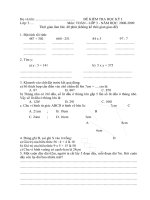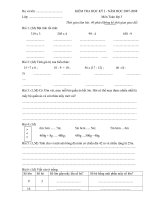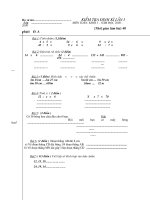1 01 GAAP powerpoint 3
Bạn đang xem bản rút gọn của tài liệu. Xem và tải ngay bản đầy đủ của tài liệu tại đây (93.62 KB, 20 trang )
1.01 Generally Accepted Accounting
Principles – Accounting Constraints,
Concepts, Assumptions, and
Principles
GAAP PowerPoint #3
Hierarchy of Qualitative
Information
Cost/Benefit
Understandability
Discussed
in PPT #2
Decision Usefulness
Relevance
Reliability
Verifiability
Timeliness
Feedback
Value
Neutrality
Representational
Faithfulness
Predictive
Value
Comparability and Consistency
Materiality
www.fasb.org
Constraints
A constraint is a limit, regulation, or
confinement within prescribed bounds.
This term refers to the accounting guidelines
that border the Hierarchy of Qualitative
Information
They consist of:
◦ Cost Effectiveness
◦ Materiality
◦ Conservatism
Cost Effectiveness Constraint
Also called Cost Benefit Constraint
The cost of providing accounting information
should not exceed the benefit of the
information it is reporting.
Example: Your checkbook register and
bank statement differs by $0.10. Rather than
waste time to find the $0.10, the accountant
should record the amount as miscellaneous
expense or income.
Materiality Constraint
Material means big enough to make a difference in
the user’s decision-making process.
States that the requirements of any accounting
principle may be ignored when there is no effect on
the decisions of the user of financial information.
Example: A company purchases a Trashcan for
$10. Per GAAP, this amount should be capitalized
as an asset and depreciated. Because the amount is
immaterial, the $10 can be recorded as an expense.
Conservatism Constraint
Accountants use their judgment to record
transactions that require estimation.
Conservatism helps the accountant choose
between 2 equally likely alternatives.
Requires the accountant to record the
transaction using the less optimistic choice.
Example: There is the potential for a customer
to sue the company. Although, the customer
may choose not to sue, the accountant will
disclose this potential lawsuit to investors.
Concepts
Concepts are the ground rules of
accounting that should be followed when
preparing financial statements.
These are:
◦ Recognition Concept
◦ Measurement Concept
Recognition Concept
States that an item should be recognized
(recorded) in the financial statements when:
◦ It can be defined by GAAP assumptions and
principles
◦ It can be measured
◦ It is relevant to decision-making by users
◦ It is reliable
Measurement Concept
States that every transaction is measured by
the stated unit of measurement, such as the
dollar
The stated procedure of valuing assets,
liabilities, equity, revenue, and expenses as
defined by GAAP
Assumptions
Assumptions are agreed upon rules of
accounting, and are basic, understood
beliefs.
There are Four Basic Assumptions of
Accounting:
◦
◦
◦
◦
Economic Business Entity
Going Concern
Monetary Unit
Time Period
Economic Business Entity
Assumption
All of the business transactions should be
separate from the business owner’s personal
transactions
There should be no co-mingling of personal
funds with business funds.
Going Concern Assumption
Financial statements are prepared under the
assumption that the company will remain in
business indefinitely unless there is sufficient
evidence otherwise.
If there is evidence that a company may
possibly have a going concern issue, this
must be disclosed in the financial statements.
Monetary Unit Assumption
Assumes a stable currency is going to be the
unit of record.
FASB accepts the nominal value of the US
Dollar as the monetary unit of record
unadjusted for inflation.
Time Period Assumption
The entity’s activities are separated into
periods of time such as months, quarters or
years.
Transactions must be accounted for within
the time period they occur regardless of
when cash is exchanged.
Principles of Accounting
Principles are accounting rules used to
prepare, present, and report financial
statements.
Principles dictate how events should be
recorded and reported.
Cost Principle
Assets are recorded at historical cost, not fair
market value.
For example, if a company purchases a
building for $500,000 it should be recorded
as such, and should remain on the books for
that amount until disposed of.
If the building appreciates to $700,000 in the
next few years, no adjustment should be
made.
Full Disclosure Principle
All information pertaining to the operations
and financial position of the entity must be
reported within the period of time in
question.
Circumstances and events that make a
difference to financial statement users should
be disclosed.
Revenue Recognition Principle
Revenue is earned and recognized upon
product delivery or service completion,
without regard to when cash is actually
received.
Also called accrual basis accounting
Example: A customer purchases inventory
from a company on credit. Even though no
cash has yet been received, the sale is
recorded.
Matching Principle
The costs of doing business are recorded in
the same period as the revenue they help
generate, regardless of when the money is
actually paid.
Also called accrual basis accounting
Example: A company orders merchandise on
credit and has 30 days in which to pay. This
purchase is recorded immediately, even
though no cash has been paid.
Questions for
Understanding/Discussion
Explain what is meant by “The benefits of
accounting information must exceed the costs.”
What is meant by the term materiality in financial
reporting?
What is meant by the term conservatism in
financial reporting?
Explain the Going Concern assumption.
Explain the Time Period assumption.
Explain the accounting principles that guide
accounting practice.









